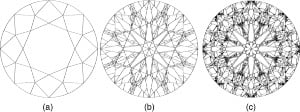Vendors and experts, including John, have criticized or at least pointed out the fact that when labs grade symmetry, it's 2-D symmetry that they grade and "Excellent" symmetry doesn't necessarily mean precise cutting from a 3-D perspective, and I've also read at various places about the superiority of 3-D precision cutting (including at http://goodoldgold.com/4Cs/NewCutGrading/OpticalSymmetry).
I understand that the super ideals must have perfect HA patterns and the lower girdles, for instance, must be cut to 77%, and that's what I've seen on reports for BGD Signature or WF's ACA diamonds, or if it's not 77%, it's 76%, which is close enough. But what would be the problem with 80% across the board? We might not like the resulting HA patterns, but still, that would yield perfect optical symmetry, would it not?
If you look at the GIA symmetry grading document I attached, it seems that it's fairly comprehensive... and some pictures do suggest 3-D symmetry grading, as opposed to 2-D grading... and even if it's all 2-D, if you've got enough views, you've got the 3-D picture, pretty much.
After having bought diamonds, it still bothers me that I can't explain to others why certain diamonds would have nice optical symmetry and others might not... I guess I just don't understand why... it seems to me that what GIA does is sufficient, at least from the document I've attached.

I understand that the super ideals must have perfect HA patterns and the lower girdles, for instance, must be cut to 77%, and that's what I've seen on reports for BGD Signature or WF's ACA diamonds, or if it's not 77%, it's 76%, which is close enough. But what would be the problem with 80% across the board? We might not like the resulting HA patterns, but still, that would yield perfect optical symmetry, would it not?
If you look at the GIA symmetry grading document I attached, it seems that it's fairly comprehensive... and some pictures do suggest 3-D symmetry grading, as opposed to 2-D grading... and even if it's all 2-D, if you've got enough views, you've got the 3-D picture, pretty much.
After having bought diamonds, it still bothers me that I can't explain to others why certain diamonds would have nice optical symmetry and others might not... I guess I just don't understand why... it seems to me that what GIA does is sufficient, at least from the document I've attached.





300x240.png)